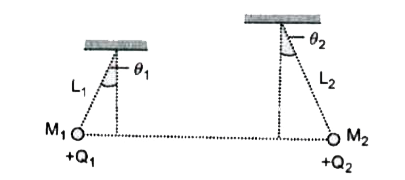A charged particle with charge q enters a region of constant, uniform and mutually orthogonal fields →E and →B with a velocity →v perpendicular to both →E and →B, and comes out without any change in magnitude or direction of →v. ThenSolution in Kannada
→v=→B×→E/B2
→v=→E×→B/E2
→v=→B×→E/E2
→v=→E×→B/B2
The correct Answer is:D
→v=→E×→BB2
⇒v=EBsin90∘B2
∴V=EBB2=EB
Topper's Solved these Questions
- ELECTRONS & PHOTONSBOOK - MODERN PUBLICATIONCHAPTER - ELECTRONS & PHOTONSEXERCISE - MULTIPLE CHOICE QUESTIONS (LEVEL-II)
63 Videos
- ELECTRONS & PHOTONSBOOK - MODERN PUBLICATIONCHAPTER - ELECTRONS & PHOTONSEXERCISE - MULTIPLE CHOICE QUESTIONS (LEVEL-III)
9 Videos
- ELECTROMAGNETIC WAVESBOOK - MODERN PUBLICATIONCHAPTER - ELECTROMAGNETIC WAVESEXERCISE - RECENT COMPETITIVE QUESTIONS
4 Videos
- ELECTROSTATICSBOOK - MODERN PUBLICATIONCHAPTER - ELECTROSTATICSEXERCISE - RECENT COMPETITIVE QUESTIONS
39 Videos
Similar Questions
Maximum frequency of the photon produced by the union of a proton and a antiproton is (given : mp=1.67×10−27kg):
View SolutionEnergy required for the electron excitation in Li++ from the first to the third Bohr orbit is :
View SolutionThe speed of electromagnetic wave in vacuum depends upon the source of radiation
View SolutionTwo small spheres of masses M1andM2 are suspended by weightless insulating threads of lengths L1andL2 The spheres carry charges Q1andq2 respectively . The spheres are suspended such that they are in level with one another and the threads are inclined to the vertical at angles of θ1andθ2 as shown . Which one o fthe following conditions , if θ1=θ2 ?

View SolutionA charged particle moving with a uniform velocity →v enters a region where uniform electric and magnetic fields →E and →B are present. It passes through the region without any change in its velocity. What can we conclude about the (i) relative direction of →E, →V and →B? (ii) magnetic of →E and →B?
or
Find the condition under which the charged particle moving with different speeds in the presence of electric and magnetic field vectors can be used to select charged particles of a particular speeds.
View SolutionIn a region, electric field →E and magnetic field →B are mutually perpendicular. If a partical of charge q enters that region with velocity →v normal to both the fields, under what condition does the direction of motion of the particle remain unchanged ?
View Solutionएक क्षेत्र में विद्युत क्षेत्र →E तथा चुंबकीय क्षेत्र →B परस्पर लंबवत है। एक इलेक्ट्रॉन इस क्षेत्र में →B और →E की दिशाओं के लंबवत प्रवेश करता है तथा अविक्षेपित रहता है, तो इलेक्ट्रॉन का वेग होगा-
View SolutionA proton with velocity vecv enters a region of uniform magnetic induction vecB , with vecv perpendicular to vecB and describes a circle of radius R. If an alpha - particle enters this region with the same velocity vecv , it describes a circle of radius
View Solutionएक आवेश q चुंबकीय क्षेत्र →B के लंबवत दिशा में →V वेग से प्रवेश करता है| इस आवेश पद कार्यरत बल का मान क्या होगा?
View SolutionWhat is the direction of the force acting on a charged. Particle q moving with a velocity →v in a uniform magnetic field →B ?
View SolutionA charged particle with charge q enters region of constant, uniform and mutually orthogonal fields →E and →B , and comes out without any change in magnitude or direction of →u, then
View SolutionA charged particle goes undeflected in a region containing electric and magnetic fields. It is possible that
i) →E∣∣∣∣→B,→V∣∣∣∣→E
ii) →E is perpendicular to →B and both are perpendicular to →V
iii) →V∣∣→B but →E is not parallel to →B
iv) →E∣∣→B but →V is not parallel to →E
View SolutionA charged particle with a constant ortheground field vecE व vecB Enters with its perpendicular velocity and V vec v Exits without any change in magnitude and direction. Then:
View SolutionUniform magnetic field vecB Velocity in vecV What is the direction of the force acting on a charged particle q moving from?
View Solutionसमष्टि के एक क्षेत्र पर विचार कीजिए जिसमें नियत, एकसमान और परस्पर लंबवत क्षेत्र →E और →B उपस्थित हैं। अब आवेश q का एक कण इस क्षेत्र में एक वेग →v के साथ प्रवेश करता है जो दोनों क्षेत्रों के लंबवत है। यदि आवेश का वेग अपरिवर्तित रहता है, तब →v का मान बताइए।
View Solution
